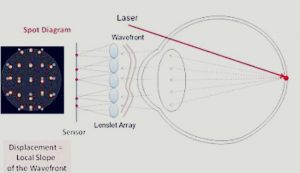An aberration refers to a defect in lens that causes the light to spread and not to converge in the same point to make the image sharp. This may occur in the whole image of the object which a person is trying to focus or a certain part of it gets defocused depending on the defect in the lens. There are several types of optical aberrations that occurs while focusing an image.
There are mainly five types of aberrations in case of light with single wavelength, called, spherical aberration, coma, astigmatism, curvature of field and distortion. A sixth aberration is found in cases when the light is not monochromatic, called, chromatic aberration.
When a bundle of light rays comes from one point of the optical axis is focused at different places rather than the focused point depending on the distance from the axis where the light incidents. This type of optical aberration is named as spherical aberration.
When a point image gets blurred like a comet shape, is called coma, this type of aberration occurs because the rays emitted from the point object is focused by different zones of the lens.
When a single zone of the refracting surface fails to focus the image astigmatism occurs, this type of aberration is very common in real life.
Curvature of field and distortion mainly refers to the location of image point with respect to one another. In case of curvature of field the image of plane object is perpendicular to the optical axis. Again, distortion refers to deformation of an image , there are two types of distortion which can be present in the lens, barrel distortion and pincushion distortion.
The last type of aberration is, chromatic aberration, it occurs when the lens fails to focus all colours in the same plane. There are mainly two types of chromatic aberration, axial and transverse.
The human eye lens is biconcave in nature, thus the light rays refracts through it following the rules of refraction through spherical lens, so the types of aberration mentioned above is applicable in case of human crystalline lens.

A spherical lens has an aplanatic point, i.e. no aberration point. The value of refractive index of eyes crystalline lens is 1.49.
When the peripheral rays are bent too much it is called “positive” aberration and when the rays are not bent too much it is called “negative” aberration.
In the lens system aberration can be minimised by using combination of concave and convex lenses or by using aspheric or aplanatic lens. In 2018, Rafeal G. Gonzalez and Hector A. Chaparo-Romo graduate students of National Autonomous University of Mexico and the Monterry Institute of Technology and Higher Education in Mexico. found a close formula for eliminating aberration from lens. Aberration can be eliminated by making lenses with an asperic surface. Descarts showed that lens whose surface are well choosen Cartesian ovals can perfectly image light from a point on the axis or from infinity to the direction of the axis. This type of design gives a complete aberration free image.
When light falls on a refracting surface it gets partially reflected, absorbed or transmitted through it. Aberration in optical systems is the deviation of light rays passing through the refracting surface causing images of objects to be blurred. Practically each formed image occupies a certain amount of volume and unsymmetrical shape causing some amount of aberration. In case of plane mirror only we get images free of aberrations, a lens is an imperfect image producer, it becomes ideal only when rays pass through its centre, parallel to the optical axis.
In last few years there has been a renaissance with the arrival of aberration correctors for the objective lens. Correctors are added in both TEM and STEM, which obtained a resolution limit around 0.1nm. The improved images from these aberration corrected microscopes are opening up new avenues in the characterization of materials. There are two basic designs of correctors, the octupole/quadrupole assembly and the hexapole assembly.
Thus, there are several types of aberration that can occur while imaging due to different shapes and properties of the refracting surface and can also be corrected by different procedures. This is a brief overview of schematic aberrations.










